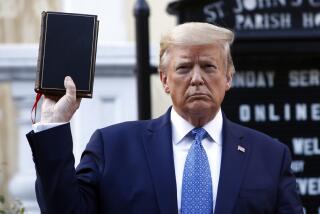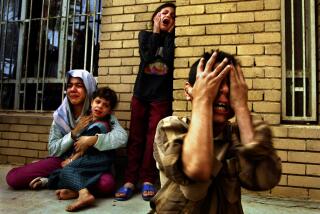Hussein Putting His Mark on Islamic Faith
- Share via
BAGHDAD — Muslims believe the Koran is the literal word of God, a divine revelation received by the prophet Muhammad centuries ago. In Iraq, the faithful can read those sacred words written in the blood of their president, Saddam Hussein.
That, at least, is what officials say: that over a period of three years the president donated 50 pints of blood that was mixed with preservatives and used to pen the more than 600 pages of the holy book.
“His excellency, when he donated this, he intended to sacrifice himself to God,” said Abdul Razzak Harbi, director of religious teaching in the Ministry of Religious Affairs.
The red-lettered text sits in a display case beneath the grand dome of the Mother of All Battles Mosque just outside this capital, another of the president’s recent religious donations to his people. Surrounding the dome are eight towering minarets--in Arabic, there are eight letters in “Saddam Hussein”--four shaped like Scud missiles sitting on a launch pad and four resembling huge machine-gun barrels.
The blood-inscribed Koran and the military-style mosque demonstrate how the ironfisted leader of this impoverished and weary country has tried to manage a deepening sense of devotion that has spread across Iraq after two wars and 10 years of sanctions. While other regimes have sought to suppress or promote fundamentalism, Hussein has decided to co-opt it.
“When a society is in crisis like we are, with the embargo and all, religion plays a greater part in soothing the psyche of the people and giving people greater strength to face the crisis,” said Ihssan Hassan, a sociology professor at Baghdad University who said he meets with Hussein every few months.
The Iraqi strongman borrowed religious symbolism during the Persian Gulf War when he decided to inscribe the Iraqi flag with “God is great.” Officials said the script used on the flag is a duplicate of the president’s handwriting.
But the full-scale “Faith Campaign” began in earnest in 1994, when Iraq was suffering from chronic shortages of food and medicine. Many people were beginning to pray five times a day, as prescribed in the Koran, and women were increasingly veiling themselves. This was threatening to a regime that promoted its leader with religious devotion, plastering the country with his image in paintings, mosaics, statues, even clocks.
“We are really against this,” Hassan said of the increasingly popular religious practices, such as women wearing head coverings. “It is a backward thing. If we could ban it, we would. We can’t.”
Even a ruler like Hussein, who has demonstrated a willingness to use force to keep his people in line, recognized he could not hold back faith. But the president, who is a Sunni Muslim, was concerned that majority Shiite Muslims would be encouraged to rebel by neighboring Iran. Hussein had already suppressed a revolt led by Shiite groups in the south after the war a decade ago. The regime also was worried that neighboring Saudi Arabia, which subscribes to a strict form of Islam known as Wahhabism, would find fertile ground in Iraq.
“Iraq was very keen to fortify the mentality of the people not to get involved with these imported ideas,” said Harbi, the ministry director of religious teaching.
To that end, Harbi said, the president single-handedly designed the religious campaign. It is being waged on many fronts: All schoolchildren are expected to complete studies of the Koran by the end of secondary school. Local radio broadcasts an all-Koran channel 18 hours a day. Iraq opened Saddam College for preparing preachers and imams. Saddam International Islamic University opened as well, providing religious training to foreign students.
And of course there is the construction. The Mother of All Battles Mosque--named after the now-famous description Hussein used for the Gulf War--a huge complex that on a recent trip was made off limits to reporters, is the smallest of three mosques being built. One where construction is just beginning is supposed to be the largest mosque in the world. It will be called the Saddam Hussein Mosque.
“When you find mosques named after the president, or you see his pictures, or maybe some preacher says his name during Friday prayer, it is when you find such a leader . . . has done something good for you, you must reward him,” said Harbi, whose own office and reception area has six pictures of the president, including a floor-to-ceiling portrait.
Many here say they are happy to adopt their president’s version of Islam. In this once cosmopolitan city, now lined with row after row of rundown, low-slung concrete buildings, many women walk around with their heads covered--a relatively rare sight before the war. Hend Tawfik, 19, says she and her mother began wearing head scarves in 1994, at the start of the religious campaign.
“The difficult circumstance we face after the embargo has reflected on our mentality by making us close to religion,” said Tawfik, who continues to wear makeup. “Before, we have faith in our hearts, but we did not implement it. Now we get closer to Islam.”
More to Read
Sign up for Essential California
The most important California stories and recommendations in your inbox every morning.
You may occasionally receive promotional content from the Los Angeles Times.













